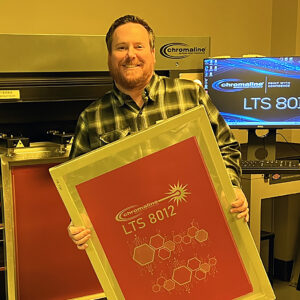
Automate Your Screen Making Process With Laser-To-Screen
The best screen prints start way before you get on press. A quality screen makes all the difference in how your final print will look. If you are ready to screen print the highest resolution images possible, you need to consider a laser-to-screen (LTS) auto screen making machine.
WATCH VIDEO: Laser-To-Screen LTS 8012 Overview
WATCH VIDEO: Best Emulsion For LTS 8012
What Is Laser-To-Screen for Screen Making?
The LTS system is a computer-to-screen system that uses lasers to image and expose your screen as a one-step process. Today we're going to be talking about our LTS 8012, but we have three models available. The LTS 8012 can do two screens at once so your throughput is much greater than a lot of the other systems that are out there. Here is a step-by-step process of how to make a screen using the LTS 8012.
STEP 1: Coat Screen
An auto-coater is required to use with our LTS units to ensure consistent and proper coating. We use our Hydro-X Premium Screen Printing Emulsion to coat our screens for our automated LTS exposure units. Hydro-X is Chromaline's latest water-resistant pure photopolymer emulsion with dual cure technology built into a ready-to-use formula. It is available in blue or red.
STEP 2: Load Screen
When loading your screens in the LTS 8012 it uses a three-point registration system. It also has the option if you're using MHM presses to use the MHM pin registration system, the same system that's on the MHM press itself. Once you put the screen (or screens) in, push the button to lock it in. Now it's ready to be imaged.
STEP 3: Output Artwork To Screen
The LTS interface is a very simple drag-and-drop system. If you are imaging two screens at once, switch over to multi-frame. Then just drag over your pre-ripped images and drop them into place. Pre-process the image or images and then click output. Your screens will begin imaging.
STEP 4: Develop & Dry Screen
Once your screens have been imaged the rest of the developing process is the same as traditional screen printing. Use a high pressure sprayer to washout your screen, then dry as usual.
Benefits of Laser-To-Screen Auto Screen Making
The LTS 8012 uses 128 lasers capable of up to 2540 DPI Max. The LTS 8012 uses no consumables like wax or inkjet ink and no need to worry about head strikes or replacing the heads because of those head strikes. The LTS can image up to two screens at once, up to 25x36. There's no vacuum, no glass, no pinholes.
The lasers are rated for 10,000 hours at 100% power. But keep in mind, for most emulsions the laser will only need to be run at about 30 to 60 percent of that power. This means you will be able to operate the LTS for many years before you need to replace those lasers (exact amount of time will depend on individual variables).
Contact Chromaline Today
The LTS 8012 is a great addition to any shop. You'd be surprised at how fast the LTS pays for itself because you're not using any consumables. If you have any further questions about one of our laser-to-screen auto screen making units, please contact us today.

